2014 Honda CBR650F First Ride Review

Rediscovering the performance of the past
Some of us remember a time when you didn’t have to be folded up like a preying mantis to ride a 600cc supersport bike. What Millenials, Generation Z, Plurals – or whatever the heck the media is calling the desirable, young market segment this week – may not know from personal experience is that something was lost in the sportbike wars over the last 20 years. Yes, we’ve seen some amazing technological advancement in power delivery and handling, but as the manufacturers went through their two year cycles of ground up reimagining of their hottest middleweights in search of the all-important racing titles across the globe, the relentless sharpening of the performance envelope has come with some costs.
2014 Honda CBR650F
| Engine | 18.75/20 |
| Suspension/Handling | 12.25/15 |
| Transmission/Clutch | 9.0/10 |
| Brakes | 7.25/10 |
| Instruments/Controls | 3.75/5 |
| Ergonomics/Comfort | 9.0/10 |
| Appearance/Quality | 8.5/10 |
| Desirability | 8.5/10 |
| Value | 8.5/10 |
| Overall Score | 85.5/100 |
EICMA 2013: 2014 Honda CBR650F
First, all that development costs money. As belts have tightened (on both personal and corporate levels), development cycles have slowed because sportbike unit sales just aren’t there to support the R&D like they were five years ago. Additionally, as the average retail price of 600cc supersport bikes has risen to around $11,500, the cash cow of the cruiser market hasn’t escaped the world’s economic struggles and isn’t able to make up the financial slack that it could for the OEMs only a few years ago.
The second – and possibly most pertinent – cost for riders who never plan to turn a wheel in anger on the race track is that the scalpel sharpness of hyper sports machinery may not lend itself to the varied uses of the street. A full racer tuck is great at 150 mph on the front straight, but it leaves a lot to be desired in the 45–65 mph commuter shuffle. Similarly, riders often find it easier to negotiate the 1st- and 2nd-gear corners on their favorite twisting roads in a more upright riding position than hunched behind the bubble. (For further discussion on this see our 2014 Super Streetfighter Smackdown and our 2014 Ultimate Streetfighter Finale.)
Honda is well aware of these issues, and following its current stated goal of growing the sport of motorcycling by creating bikes that appeal to younger riders, the introduction of the 2014 CBR650F should come as no surprise. On paper, the $8,499 CBR650F initially looks like it cheapens the CBR line which (until the release of the CBR500R last year) stands as the flagship designation for Honda’s supersport machinery. Instead, after sampling the 650F, I believe the key to Big Red’s newest sportbike is in the letter F – as in the CBR600F, F2, F3, and F4. They all won races and, in some cases, championships, but they still carried, to a point, a more real-world approach to sport riding.
In case you’re thinking that I’m jumping the shark with this train of thought, those previous F models were state-of-the-art for their time. The 2014 CBR650F clearly is not. However, it is looking back to the streetable performance that, arguably, was lost with the adoption of the RR designation. Honda then applied the same value for money approach that prompted our Top 10 Value-For-Money Hondas article. Had the CBR650F been available for a full test prior to our planning of those articles, it likely might have been included in that list.
So, how did the smart folks at Honda go about creating the CBR650F and what exactly makes it special? Let’s dig in a little and see.
The Engine Room
The CBR650F’s engine is a ground-up creation. Instead of going for maximum horsepower at stratospheric rpm, the design was directed at the low- and mid-range power delivery for street use. The goal was to build a beefy torque curve to be utilized off the line – as in from a stop light – that delivers instant roll-on power through the mid-range. Although the power would continue to build from 6,000 rpm to the relatively mundane 11,000-rpm redline, the emphasis was placed on the range that would give the most benefit to street riding.
2014 Honda CBR650F Coming To US
Since the 650F has no racing aspirations, there’s no need to stick with a 600cc displacement limit. So, to improve mid-range drive, displacement gets bumped up a bit. While you might not think 50cc would make much of a difference, it does. The 67.0mm x 46.0mm bore and stroke yield a pleasant 649cc of usable grunt.
The engine layout was structured to help achieve a centralized mass low in the chassis, helping to distribute weight evenly between the wheels. The block’s forward lean also helps in power delivery. Honda’s engineers created the straightest path possible for the air and fuel to travel through the engine. Long, narrow 30mm intake funnels lead to the 32mm throttle bodies. As the fuel charge enters and exits the cylinders, minimal valve overlap improves the power and fuel efficiency in the lower-rpm range. Aside from the headers being visually inspired by the 1974 CB400 four, the four-into-two-into-one exhaust system features “air regulating panels” that shape the performance characteristics while maintaining the desired system dimensions for mass centralization and visual design goals.
The 30-degree forward cylinder cant and the vertically stacked transmission help mass centralization and shorten the engine length. To further assist in compactness, the thermostat was moved to the front of the engine for improved coolant routing.
The engine includes numerous efficiency-improving items. For example, breathing holes between crankcase journals minimize pumping loss particularly at high rpm. Both the piston pins and connecting rods wear a coating to minimize frictional losses and increase longevity.
Framed
One obvious cost-saving measure with the CBR650F is the use of a steel frame rather than a lighter, more expensive aluminum one. However, that doesn’t mean the designers didn’t have some fun with it. Rather than using round steel tubes, 67mm x 46mm oval tubes were selected. According to Honda, this allows for tunable flex with the tube being stiffer on the plane of the wider cross-section. The oval tubes also help to keep the bike’s profile as narrow as possible. Forged-molding pivot plates contribute to the strength and narrowness around the CBR’s waist, easing the reach to the ground from the 31.9 in. seat.
The engine bolts to the frame as a stressed member via aluminum hangers. While Honda did spend the money for a shapely aluminum swingarm, the shock that bolts directly to it only has a seven-position, ramped preload adjuster to modify its behavior over 5 in. of travel. The non-adjustable 41mm conventional fork has 4.7 in. of travel.
Atop the triple clamp is a sign of the 650F’s real-world intent: The clip-ons are mounted on above the triple tree – with risers. This forward-most corner of the rider triangle is higher and more rearward than on a CBR600RR. The pegs are lower than the RR and have rubber pads and weights on the bottom – typical measures to quell vibration. The ergonomics feel like a good compromise for switching between urban commuter and rural sport duties.
The corner of the triangle played by the rider’s butt is slightly forward on the chassis to get his/her body closer to the CBR’s center of gravity (CG) when compared to the RR. According to the Honda representatives, this gives the feeling of being more at one with the motorcycle. It does make the 650F feel lighter than its fully fueled 461-lb. claimed weight might imply.
The rider triangle places the rider in an upright, slightly forward leaning position from which to control the vehicle. In low-speed situations or extremely tight turns on the street, this is preferable to a full tuck. The seat narrows at the front easing the reach to the ground while the remainder of the one-piece saddle offers room to move around when the road goes all serpentine on you.
Head to the Hills
Approaching the CBR650F, whether it’s the Honda Red, Candy Blue, or Matte Black Metallic, reveals the family resemblance – though less with the RR and more with the older F4i’s front end appearance (which as a former F3 owner, I really liked). The new, abbreviated tail section is sexier than the F3/F4 ever were. We expect the rich red on a Honda sportbike, but the Candy Blue is especially striking. The matte finish of the black 650F really shows off the various curves of the bodywork in direct sunlight.
The engine has a pleasant growl at idle. The instrument cluster’s design is clean and utilitarian. The left LCD panel gives a bar graph for the tachometer and a large numerical readout for the speedometer. A small central panel has high beam and turn signal lights as well as the select and reset buttons for the right LCD panel’s readout. The right LCD contains a clock, fuel gauge, dual trip meters, current mpg and average mpg.
2013 Honda CBR600RR – First Ride Street Impression
Although the windscreen appears adjustable, like it is on the NC700X, looks here are deceiving. A taller accessory windscreen will be available. At freeway speeds, the wind blast is directed at the mid-chest of a 5’ 11” rider with the helmet being in clear air. The riding position is quite comfortable with the forward lean matching nicely with the wind. The grips feel moderately close and at a comfortable height for both urban and sporting duty. Unlike with many harder-nosed sportbikes and their narrow grips, the 650F’s are wide enough to offer strong leverage for directional changes.
The leverage is appreciated when the road turns twisty, as is the ability to move around on the seat. Reaction to inputs is quick but not lightning fast as you might expect from a supersport spec 600. When the pace gets a bit too hot, the pegs that seem just right for most riding duties reveal they are just a tad low, dragging feelers a bit earlier than we would have liked. Part of this can be attributed to the standard #2 preload setting on the shock. Adding a notch to the preload gave a smidge more ground clearance, firmed up the rear suspension and quickened the steering slightly.
For a non-adjustable fork, Honda seems to have nailed the settings for a 180 lb. rider plus gear. Riders who are used to twiddling compression and rebound adjusters will miss the activity. However, our day riding in the Santa Monica Mountains on pavement ranging from brand new to cracked and chunked showed how well sorted the CBR650F is. Abrupt maneuvers coupled with large bumps could get the the chassis out of shape, but our elevated pace didn’t expose any major shortcomings in the suspenders. Since the entry price for the 650F is so reasonable, upgrading suspension components if you desire won’t seem like such a burden.
Core Strength
Compared to the peakiness of track-oriented 600s, the 650F’s engine could be run a gear (and sometimes two) higher in corners. In fact, corners that would normally require first gear could be taken in second, which softened the hitch in power delivery when reapplying throttle. Usable power is available from around 4,000 rpm all the way to redline. The mid-range tractability is so impressive that many riders may not mind the muted top end rush that comes as a consequence of the middle-heavy power curve. The clutch is easy to modulate, and the shifts were positive, slick operations.
The only two complaints I have about the engine are the slight Inline-Four vibration that makes itself apparent at certain rpm and the aforementioned on-throttle hiccup. The vibration never really becomes bothersome, and with measured application and timing of throttle roll-on, the abruptness can be ridden around.
The CBR650F’s brakes are more than capable for the performance street riding tasks we threw at them. The dual 320mm wave discs bolt directly – without carriers – to the wheels. The two-piston calipers offer plenty of stopping power, though not with the feel of monobloc units of pricier bikes. For $500, there is an ABS option which is only available in the black model. We were happy learn neither the standard nor the ABS brakes are linked.
After a day riding some of the best roads in the Santa Monica Mountains, I’m impressed with Honda’s sportbike for street riders – be they beginners, step-up riders from smaller bikes, or just fans of sporting street machinery. They can purchase a lot of bike to use in the real world for $8,499 or $8,999 for the ABS model.
While it may lack the cool new technology and some components we’ve come to expect (like an inverted fork and radial brakes), the CBR650F is not a slouch on any scale. Ten years ago, a bike of this level of performance would have been close to cutting edge. Yes, Honda cut some corners in the suspension, but the reality is that the stock setup is more than adequate for most street riders. If an owner does outgrow the suspension’s capabilities, the aftermarket can always provide a fix.
+ Highs
- Strong low- and mid-range power
- Real-world sport-riding utility
- $3,000 less than CBR600RR
– Sighs
- Limited ground clearance for aggressive riding
- $500 ABS option only available in black
- Yamaha FZ-09 costs less

Like most of the best happenings in his life, Evans stumbled into his motojournalism career. While on his way to a planned life in academia, he applied for a job at a motorcycle magazine, thinking he’d get the opportunity to write some freelance articles. Instead, he was offered a full-time job in which he discovered he could actually get paid to ride other people’s motorcycles – and he’s never looked back. Over the 25 years he’s been in the motorcycle industry, Evans has written two books, 101 Sportbike Performance Projects and How to Modify Your Metric Cruiser, and has ridden just about every production motorcycle manufactured. Evans has a deep love of motorcycles and believes they are a force for good in the world.
More by Evans Brasfield




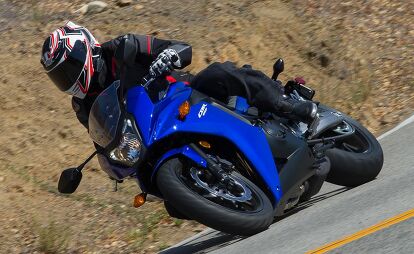





















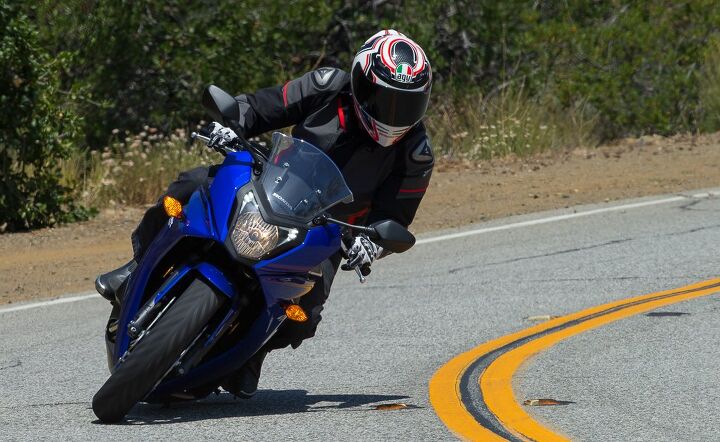



















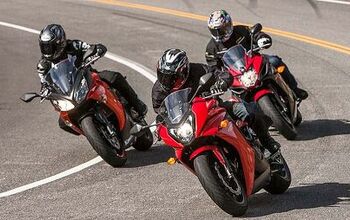
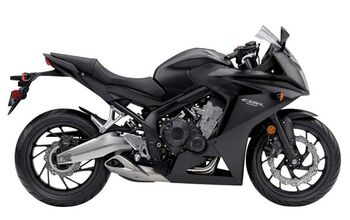
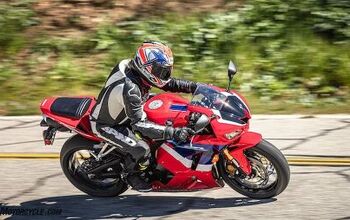










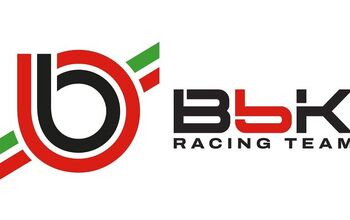


Comments
Join the conversation
I read a variety of online moto-journals, and have been reading this site for a few years. Lately, I noticed you guys have really done a great job with the reviews (thinking of this review and the Nine T). Keep it up!
You mention the FZ-09 costs less as a "Low", but is the 09 this easy to ride?